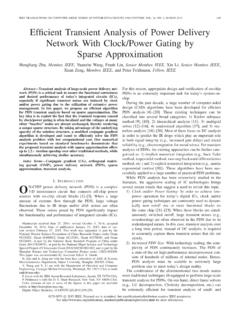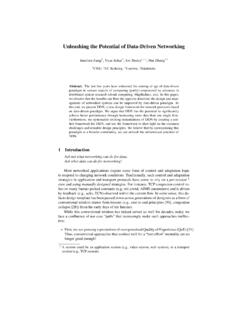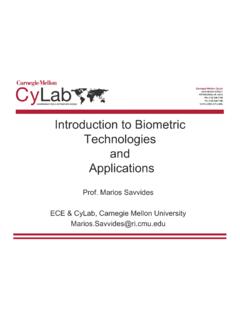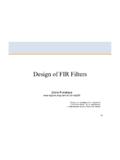Transcription of Tutorial: Checksum and CRC Data Integrity Techniques for ...
1 1 Tutorial: Checksum and CRC Data Integrity Techniques for AviationMay 9, 2012 Philip KoopmanCarnegie Mellon DriscollBrendan HallHoneywell LaboratoriesThe views and opinions expressed in this presentation are those of theauthor, and are not necessarily those of the Federal Aviation Administration,who sponsored this work under contract DTFACT-11-C-00005. This presentationdoes not contain any technical conclusions funded by this Introduction Motivation why isn t this a solved problem? Parity computations as an example Error code construction and evaluation (without scary math) Example using parity codes Checksums What s a Checksum ?
2 Commonly used checksums and their performance Cyclic Redundancy Codes (CRCs) What s a CRC? Commonly used CRC approaches and their performance Don t blindly trust what you hear on this topic A good CRC is almost always muchbetter than a good Checksum Many published (and popular) approaches are suboptimal or just plain wrong There are some topics to be careful of because we don t know the answers Q&A3 Checksums and CRCs Protect Data Integrity Compute check sequence when data is transmitted or stored Data Word: the data you want to protect (can be any size.)
3 Often Mbytes) Check Sequence: the result of the CRC or Checksum calculation Code Word= Data Word with Check Sequence Appended To check data Integrity : Retrieve or receive Code Word Compute CRC or Checksum on the received Data Word If computed value equals Check Sequence then no data corruption found (There might be data corruption! But if there is, you didn t detect it.)Code WordData WordCheck SequenceCRC orChecksumCalculation4 Potential CRC/ Checksum Usage Scenarios Network packet Integrity check Image Integrity check for software update Boot-up Integrity check of program image , flash memory data Integrity check FPGA configuration Integrity check Configuration Integrity check , operating parameters in EEPROM RAM value Integrity check5 Why Is This A Big Deal?
4 Checksums are pretty much as good as CRCs, right? In a word NO! Typical studies of checksums compare them to horrible CRCs Would you prefer to detect all 1 & 2-bit errors ( Checksum ) orall possible 1, 2, 3, 4, 5-bit errors (CRC) for about the same cost? CRCs have been around since 1957 aren t they a done deal? In a word NO! There wasn t enough compute power to find optimal CRCs until early results are often notvery good There is a lot of incorrect writing on this topic .. that at best assumes the early results were good Many widespread uses of CRCs are mediocre, poor, or broken Our goal today is to show you where the state of the art really is And to tune up your sanity check detector on this topic Often you can get many orders of magnitude better error detectionsimply by using a good CRC at about the same cost6 Error Coding For Poets(who know a little discrete math)
5 The general idea of an error code is to mix all the bits in the data word to produce a condensed version (the check sequence) Ideally, every bit in the data word affects many check sequence bits Ideally, bit errors in the code word have high probability of being detected Ideally, more probable errors with only a few bits inverted detected 100% of the time At a hand-wave, similar to desired properties of a pseudo-random number generator The Data Word is the seed value, and the Check Sequence is the pseudo-random number The ability to do this will depend upon.
6 The size of the data word Larger data words are bigger targets for bit errors, and are harder to protect The size of the check sequence More check sequence bits makes it harder to get unlucky with multiple bit errors The mathematical properties of the mixing function Thorough mixing of data bits lets the check sequence detect simple error patterns The type of errors you expect to get(patterns, error probability)Data WordCheck Sequence7 Example: Parity As An Error Detection Code Example error detection function: Parity XOR all the bits of the data word together to form 1 bit of parity How good is this at error detection?
7 Only costs one bit of extra data; all bits included in mixing Detects all odd number of bit errors (1, 3, 5, 7, .. bits in error) Detects NO errors that flip an even number of bits (2, 4, 6, .. bits in error) Performance: detects up to 1 bit errors; misses all 2-bit errors Not so great can we do better?8 Basic Model For Data Corruption Data corruption is bit flips ( bisymmetric inversions ) Each bit has some probability of being inverted Weight of error word is number of bits flipped (number of 1 bits in error)
8 Error detection works if the corrupted Code Word is invalid In other words, if corrupted Check Sequence doesn t match the Check Sequence that would be computed based on the Data Word If corrupted Check Sequence just happens to match the Check Sequence computed for corrupted data, you have an undetected error All things being equal (which they are not!!!) probability of undetectederror is 1 chance in 2kfor a k-bit check sequence9 Example: Longitudinal Redundancy Check (LRC) LRC is a byte-by-byte parity computation XOR all the bytes of the data word together, creating a one-byte result (This is sometimes called an XOR Checksum but it isn t really integer addition, so it s not quite a sum )10 How Good Is An LRC?
9 Parity is computed for each bit position (vertical stripes) Note that the received copy of check sequencecan be corrupted too! Detects all odd numbers of bit errors in a vertical slice Fails to detect even number of bit errors in a vertical slice Detects all 1-bit errors; Detects all errors within a single byte Detects many 2-bit errors, but not all2-bit errors Any 2-bit error in same vertical slice is undetected 0 0 1 0 0 1 0 0 1 0 1 1 1 0 0 0 1 1 1 1 1 1 1 1 0 0 0 0 0 0 0 10 1 1 0 0 0 1 00 1 1 0 0 0 1 0computedNo Errors 0 0 1 0 0 0 0 1 1 1 1 0 0 1 1 1 1 1 1 0 0 0 0 0 0 0 1011000 1 1 0 0 0 000 0 0 0 0 1 1 0computedDetected Error 0 0 1 0 0 1 0 0 1 0 1 1 1 0 0 1 1 1 1 1 1 0 0 0 0 0 1001100 1 1 0 0 1 110 1 1 0 1 0 1 1computedUndected Error!
10 Red bits are transmission or storage errorsNo MatchMatch!!ReceivedCheckSequenceReceive dDataWordComputedLRC11 Error Code Effectiveness Measures Metrics that matter depend upon application, but usual suspects are: Maximum weightof error word that is 100% detected hamming distance (HD) is lowest weight of any undetectable error For example, HD=4 means all 1, 2, 3 bit errors detected Fraction of errorsundetected for a given number of bit flips hamming Weight (HW): how many of all possible m-bit flips are undetected? HW(5)=157,481 undetected out of all possible 5-bit flip Code Word combinations Fraction of errorsundetected at a given random probability of bit flips Assumes a Bit Error Ratio (BER)










